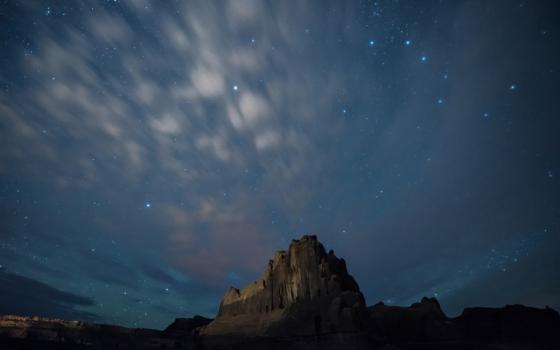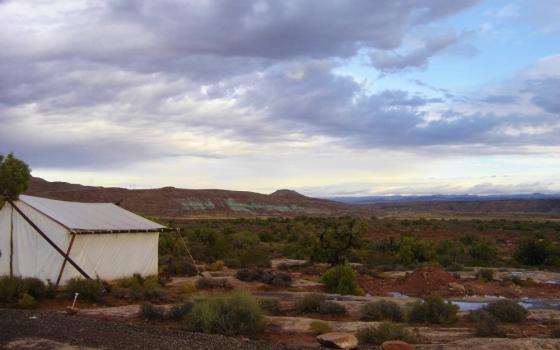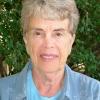It’s called Moab Under Canvas, and it is located just down the road from Arches National Park in southern Utah. Friends and I decided that as long as we were in Salt Lake City for the Parliament of World Religions we would drive down to see what many believe to be one of the more specular national parks. We needed a place to stay, and funds were limited. Moab under Canvas seemed just the right spot. The tents were already set up with hard linoleum and throw rugs placed on the floor. Each one was equipped with comfortable beds and warm blankets; the rest rooms were clean and more than adequate — and the price was right. The one concern, however, was that our stay would take place in mid-October. It could be pretty cold at night at that time of year. So we came prepared with heavy sweaters, long underwear, hats and gloves. Little did we know!
The weather, it turned out was unseasonably warm. We experienced that as a real blessing as we hiked the park. That same warm weather brought violent thunder and lightning storms two out of the three nights while we were happily ensconced in our safari-tent home. The lightning lit up the tent brighter than the noon-day sun, and the thunder, bouncing off the nearby canyon walls, must have awakened the dead, at least momentarily. The Earth shook under me. As I lay in bed, whispering a silent prayer for safety for all of us, I remember Thomas Berry telling us: “You want to teach someone reverence? Leave them out in the wilderness for a while. They’ll get reverent real quick.”
I find experiences like the above are like food that when properly digested become bone of our bone and flesh of our flesh. So, two months later I find myself still “chewing” on it. I felt so small that night the Earth shook, as I did taking in the 360-degree breathtaking panorama of Arches National Park. And then there was Canyon Lands National Park and Dead Horse Point, a state park, both of which we unexpectedly found were close enough to tack on to our visit. I have often marveled about how the night sky gives a window on the past. Well, so does layer upon layer upon layer of rock on this third planet from the sun in our tiny solar system. Indeed we humans are just a speck in time and space in the immensity of a mind-boggling, ever-expanding universe.
However, what most surprises me in the above reflection is that I loved the feeling of being so small. There is something so very right about it. It is true. It is who we really are. “The truth will set you free,” it reads in John’s gospel. That’s the thing about the wilderness: We are given the opportunity to embrace the truth of who we are, and where we fit in this vast universe in a way few other places offer. And when we do, an enormous weight is lifted from our shoulders because we are open to what really is.
All of this stands in sharp contrast to a conversation I had recently with a gentleman who attended a day of prayer I presented on the Pope’s new encyclical, Laudato Si’. He approached me before we got started and introduced himself as an ardent environmentalist eager to get things moving faster in a positive direction. I wondered to myself about whether the way I planned the day would meet his expectations. As we got started he was strangely silent. I asked everyone to spend some time reflecting on the “Blue Marble” photo of the planet, underneath which I had inserted a sentence from the encyclical: “The Divine and the human meet in the slightest detail in the seamless garment of God’s creation, in the last speck of dust of our planet.” (9) There was much discussion about the oneness of the planet, its integrity, the absence of human boundaries, and the one water system.
When we got around to those sections in the encyclical in which the Holy Father notes the need for international solutions to problems such as climate change, governance of the oceans and other global commons, the ardent environmentalist objected vehemently. “That’s dangerous, that’s dangerous,” he cried. It’s one world government. When I referred back to the actual photograph of the planet, highlighting once again the single water system and atmosphere, pointing out that the very structure of the planet will settle for nothing other than international cooperation, he refused to be appeased. The geophysics of the planet took second place to his ideas. Since this was a day of prayer on the encyclical as distinguished from a study day I raised the question, “Why would God set in motion a process of evolution resulting in a planet that demands international cooperation? “ One woman responded immediately, “Because God is community.”
Two very different experiences — in the first, the “isness” of the planet teaches, the revelation is received and deeper freedom is experienced. In the second, preconceived ideas refuse to surrender to reality, and the truth of who God is and who we are cannot break through. Although one might be tempted to apply the above in way which would prove one’s own point of view on any number of pressing global issues, there is something far more significant at stake than who is right or wrong in a given instance. It is our capacity to be influenced by incoming data. In the political arena the failure to be able to do this is what characterizes ideology. It can be summarized by the tongue-in-cheek statement, “Don’t confuse me with the facts.”
In the spiritual life incapacity or unwillingness to be influenced by incoming data of any sort is the harbinger of death. It is the rocky soil in which the seed can develop no roots. It is the hardened heart of Meribah. It is the refusal to open the door which allows The Guest to come in and dine with us. It manifests itself in petrified God images, a fixation on the trivial, and a literalizing of metaphors which leaves us confined in what is way too small. We end up carrying the weight of the world on our shoulders because we are at war with the truth of what is.
The most annoying part of all the above is that, if we are honest with ourselves, we must admit that depending on circumstances we inhabit both spaces. At times, blessedly, we find ourselves open and receptive to wisdom offering itself to us; on other occasions, we simply cannot manage to get beyond our own fears and preconceived notions.
In an Advent e-course presented by Spirituality and Practice and offered by mystic and hermit Cynthia Bourgeault, we were reminded that the desert mothers and fathers are universal in their agreement that, “Flowery words and rhetoric are not needed with God, for God already truly knows what is going on in our lives and in our hearts.” Bourgeault then reminded us of the opening of the sixth century Rule of St. Benedict: “Listen with the ear of your heart.” She suggested we embody this gesture by “Stretching out our hands.”
This story is reminiscent of another Bourgeault tells about the late Anthony Bloom. It seems that a gentleman in the throes of profound confusion amidst a deep search for God sought advice from the archbishop. Bloom listened carefully and compassionately and then suggested the man come back in a month. In the interim however, he asked him to make 100 full prostrations a day. The gentleman returned a month later with a heart softened and opened to receive.
Life, despite its moments of suffering, is fundamentally benevolent, holding out to us invitations for ever-increasing wisdom . I believe this to be the case because ours is a God who wishes to be known. To quote Bourgeault for the final time: “At the innermost depth of our being, the human and the divine are always commingling in a dynamic and life-giving exchange.” The question is: Are our hearts open?
[Margaret Galiardi, is a Dominican Sister from Amityville, New York, whose passion is the contemplative integration of justice and peace for people and planet. She is a “lover of the wild,” a spiritual director and workshop and retreat leader who has lectured nationally on the New Cosmology and the Christian Story. She spent a year living with the Trappistine monks in their monastery on the Lost Coast of Northern California in the Redwood Forest.]



